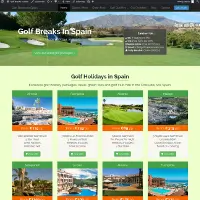SEO & Web Design Consultant Norfolk
With over 16 years experience, I specialise in professional Search Engine Optimisation and web design services. My SEO strategies will give your website maximum visibility, growth, sales, and revenue at an affordable price. The websites that I build are fully responsive, have great usability, are search engine friendly and will convert more of your visitors into paying customers.

SEO
If you are not on the first page of Google, you will be missing out on a lot of business. My organic Search Engine Optimisation services will get your site where it can be seen by potential customers.

Web Design
Your website should be a sales funnel. A website needs to be responsive to all tech devices and offer a great user experience (UX). If not, your customers won't stick around for too long. Find out about my web design services.

Web Services
Do you have an established website and need someone to maintain the content and keep your digital asset secure? Call me and find out how I can help keep your website in tip-top condition.
What is SEO and why do I need it?
If you have a business website and want to attract more visitors, then it is imperative that you can be found via the major search engines including Google and Bing. Unless you can be found in the top 10 positions of the search engine results pages (SERPS) for your most important business keywords, it is unlikely that you will get many visitors to your site. By performing regular and consistent Search Engine Optimisation (SEO) including keyword research, competitor analysis, landing page optimisation and link building strategies, your site can appear where it needs to be, right at the top of the search results. Click the button below and learn more about my SEO packages for your business.
Get a free SEO Audit
Are you considering an SEO campaign and would like to know where you need to improve?
My SEO audit will highlight what is stopping your site from ranking well and how it can be improved to not only improve positioning but also improve usability and conversion.
Website load times are also crucial to usability and ranking and the report will also suggest changes that can be made to improve these.
- Learn about issues that may be stopping you from ranking
- Hightlight road blocks to your success
- Receive a free SEO report
- Take action and start ranking!
Complete the form below and I will send you your FREE report within 48 hours!
What my customers are saying...



SEO and Web Design FAQs
Although it can take a while to rank, once you do, the traffic that you get is all free, unlike paid ads where the visitors will stop as soon as you stop paying. Once you are established, it takes just a little consistent effort to stay there. This means cheap traffic and business leads to your website.
This will depend entirely on the keyword you are looking to rank for. Broad and highly competitive keywords can take many months or even years, however, lower volume, more specific keywords can take days or weeks.
No. I do not use contracts as a part of my services.
Yes. A 50% deposit is required at the start before work commences with the balancing 50% payable on completion.
Yes, 100%. Everything I do including on-site and off-site SEO is strictly within Google’s guidelines and best practices.
No, of course not. If you are local to myself this is an option otherwise a phone call, some emails or video chat should do the trick.
I work with WordPress which is by far the most popular CMS on the web. I also use Elementor for website design.
Yes, this is standard practice. Each month I will send you are report so that you can see how things are progressing in terms of your rankings, traffic, conversions and much more.
Budgets for marketing purposes come in all shapes and sizes and I can generally accommodate a client regardless of their budget. However, it is important to note that you will need to budget a sufficient amount each month to push your website effectively.
Who am I and what is my experience?
A Long History
I originally began working as an SEO consultant in Spain while living there back in 2005. In 2011, I moved back to the UK and have been serving local businesses ever since.
An Holistic Approach to Digital Marketing
I don’t believe in a one-size-fits-all all approach when it comes to developing and promoting websites. Businesses come in different shapes and sizes and that’s exactly how I see my packages; flexible yet bespoke.
I not only specialise in building beautiful responsive websites, I also go to great lengths to get them to rank well in Google using my professional SEO services. With more than 16 years experience as an internet engineer, SEO and web designer, I know what it takes to get your website to the top of Google so you can start attracting more business sales and leads in the shortest possible time.
Going the Extra Mile
Unlike other SEO consultants, I go the extra mile and give all of my clients more ‘bang for their buck‘. My customer service is second to none. During any project, I am constantly on-hand to make sure all of YOUR objectives are being met and that I am fulfilling all of YOUR goals and expectations.
Local SEO in Norfolk with Global Reach
It doesn’t matter where your business is based. I am based in Thetford, Norfolk and conveniently located to work with businesses within the local area. But don’t worry if you are not based in Norfolk. Modern technology means that I can just as easily liaise with my clients via internet chat on a regular basis.

Rob Griggs
SEO Consultant & Web Designer
Service Areas
I can provide SEO, Web Design and Digital Marketing services to local businesses in the following Norfolk and Suffolk areas. This is not an exhaustive list. If you are not located locally to myself I can still help.
